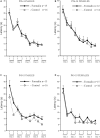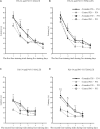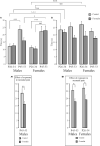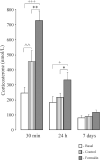The Long-Term Effects of Neonatal Inflammatory Pain on Cognitive Function and Stress Hormones Depend on the Heterogeneity of the Adolescent Period of Development in Male and Female Rats
- PMID: 34366805
- PMCID: PMC8334561
- DOI: 10.3389/fnbeh.2021.691578
The Long-Term Effects of Neonatal Inflammatory Pain on Cognitive Function and Stress Hormones Depend on the Heterogeneity of the Adolescent Period of Development in Male and Female Rats
Abstract
Exposure to stress at an early age programs the HPA axis which can lead to cognitive deficits in adults. However, it is not known whether these deficits emerge in adulthood or are expressed earlier in life. The aims of the study were to investigate (1) the immediate effects of early injury-induced stress in one-day-old (P1) and repeated stress on at P1 and P2 rat pups on plasma corticosterone levels; and (2) examine the subsequent long-term effects of this early stress on spatial learning and memory, and stress reactivity in early P26-34 and late P45-53 adolescent male and female rats. Intra-plantar injection of formalin induced prolonged and elevated levels of corticosterone in pups and impaired spatial learning and short- and long-term memory in late adolescent males and long-term memory in early adolescent females. There were sex differences in late adolescence in both learning and short-term memory. Performance on the long-term memory task was better than that on the short-term memory task for all early adolescent male and female control and stressed animals. Short-term memory was better in the late age control rats of both sexes and for formalin treated females as compared with the early age rats. These results are consistent with an impaired function of structures involved in memory (the hippocampus, amygdala, prefrontal cortex) after newborn pain. However, activation of the HPA axis by neonatal pain did not directly correlate with spatial learning and memory outcomes and the consequences of neonatal pain remain are likely multi-determined.
Keywords: adolescence; corticosterone; neonatal pain; sex differences; spatial learning; spatial memory.
Copyright © 2021 Butkevich, Mikhailenko, Vershinina and Barr.
Conflict of interest statement
The authors declare that the research was conducted in the absence of any commercial or financial relationships that could be construed as a potential conflict of interest.
Figures







Similar articles
-
Sexual Dimorphism in the Effect of Neonatal Inflammatory Pain on Stress Reactivity of Hormonal Response and Cognitive Functions in Adult Rats.J Evol Biochem Physiol. 2022;58(2):353-363. doi: 10.1134/S0022093022020053. Epub 2022 May 16. J Evol Biochem Physiol. 2022. PMID: 35599637 Free PMC article.
-
Inflammation early in life is a vulnerability factor for emotional behavior at adolescence and for lipopolysaccharide-induced spatial memory and neurogenesis alteration at adulthood.J Neuroinflammation. 2014 Sep 17;11:155. doi: 10.1186/s12974-014-0155-x. J Neuroinflammation. 2014. PMID: 25224537 Free PMC article.
-
Effects of social instability stress in adolescence on long-term, not short-term, spatial memory performance.Behav Brain Res. 2013 Nov 1;256:165-71. doi: 10.1016/j.bbr.2013.08.011. Epub 2013 Aug 12. Behav Brain Res. 2013. PMID: 23948213
-
Effects of maternal corticosterone and stress on behavioral and hormonal indices of formalin pain in male and female offspring of different ages.Horm Behav. 2009 Jan;55(1):149-57. doi: 10.1016/j.yhbeh.2008.09.008. Epub 2008 Oct 7. Horm Behav. 2009. PMID: 18955060
-
Sex differences in chronic stress effects on memory in rats.Stress. 2002 Sep;5(3):205-16. doi: 10.1080/1025389021000010549. Stress. 2002. PMID: 12186683 Review.
Cited by
-
Sexual Dimorphism in the Effect of Neonatal Inflammatory Pain on Stress Reactivity of Hormonal Response and Cognitive Functions in Adult Rats.J Evol Biochem Physiol. 2022;58(2):353-363. doi: 10.1134/S0022093022020053. Epub 2022 May 16. J Evol Biochem Physiol. 2022. PMID: 35599637 Free PMC article.
-
Orientin Reduces the Effects of Repeated Procedural Neonatal Pain in Adulthood: Network Pharmacology Analysis, Molecular Docking Analysis, and Experimental Validation.Pain Res Manag. 2023 Nov 24;2023:8893932. doi: 10.1155/2023/8893932. eCollection 2023. Pain Res Manag. 2023. PMID: 38047157 Free PMC article.
-
Intertemporal Improvement in Physicians' Perceptions of the Short-Term Adverse Outcomes of Neonatal Pain: Results of a Two-Time-Point National Survey.Children (Basel). 2024 Apr 15;11(4):471. doi: 10.3390/children11040471. Children (Basel). 2024. PMID: 38671688 Free PMC article.
-
Effects of different types of neonatal pain on somatosensory and cognitive development in male juvenile rats.Brain Behav. 2023 Dec;13(12):e3309. doi: 10.1002/brb3.3309. Epub 2023 Nov 15. Brain Behav. 2023. PMID: 37968885 Free PMC article.
References
LinkOut - more resources
Full Text Sources

